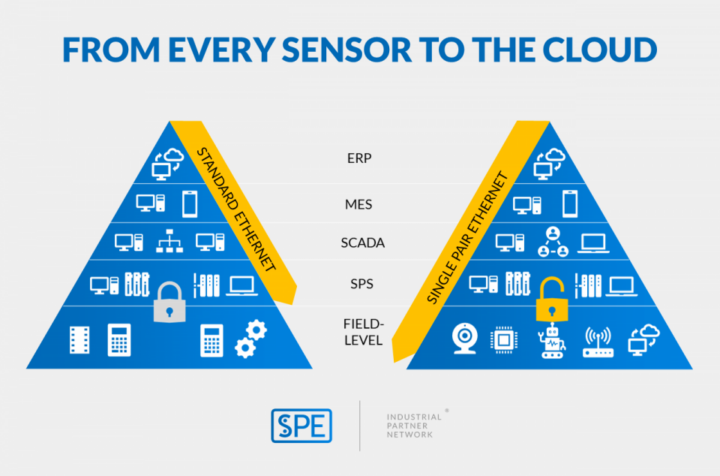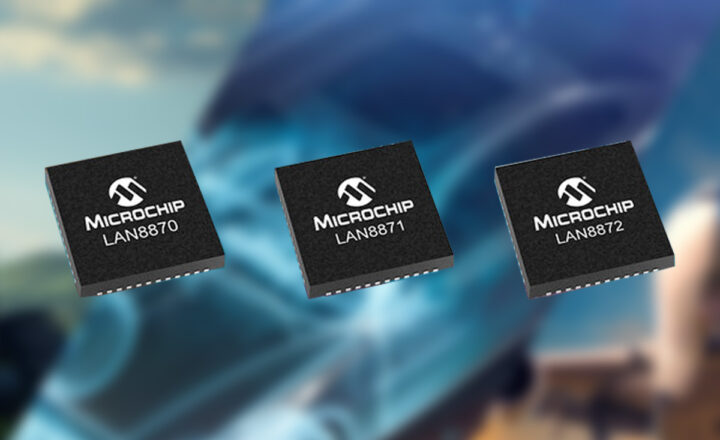Microchip has released the LAN887x family of single-pair gigabit Ethernet transceivers adding to their line of Single Pair Ethernet (SPE) devices. This new family of transceivers supports 100BASE-T1(compliant with IEEE 802bw-2015) and 1000BASE-T1(compliant with IEEE 802.3bp) network speeds and can handle extended cable lengths up to 40 meters. They also integrate time-sensitive networking (TSN) protocols and comply with ISO 26262 functional safety standards. Additionally, they can operate in low-power mode with features like EtherGREEN technology and OPEN Alliance TC10 sleep mode. All these features make this IC useful for applications such as automotive, industrial, avionics, robotics, and automation fields.
Microchip previously released the LAN8770 100BASE-T1 Ethernet PHY Transceiver which has a max cable length of 15 meters for UTP (Unshielded Twisted Pair) cable and 40 meters for STP (Shielded Twisted Pair) cable. The speed was limited to 100 Mbps, but now, with the release of the new 1000BASE-T1 ethernet controllers, the data transmission speed has been significantly increased to 1 Gbps.
Microchip’s Ethernet single-pair transceiver specifications
- Device – LAN887x family of Ethernet PHY Transceiver
- LAN8870 with RGMII and SGMII interfaces, extended cable reach for 1000BASE-T1 Type B (up to 40 meters)
- LAN8871 with RGMII interface and similar features as LAN8870, but does not support the extended cable reach for Type B (See Cable reach section for details).
- LAN8872 with SGMII interface and similar features as LAN8870, but does not support the extended cable reach for Type B.
- Supported standards
- IEEE 802.3bw-2015 (100BASE-T1)
- IEEE 802.3bp-2016 (1000BASE-T1)
- OPEN Alliance TC10 (ultra-low power sleep and wake-up)
- IEEE 802.1AS-2020 (Time-Sensitive Networking)
- IEEE 1588-2019 (Precision Time Protocol)
- MAC interfaces – RGMII and SGMII
- Cable reach
- Type A – At least 15 meters
- Type B (LAN8870B only) – At least 40 meters (potential for even longer reach)
- Power management
- FlexPWR technology for variable I/O and core power supply
- EtherGREEN energy-efficient technology
- Diagnostics
- Cable defect detection
- Receiver Signal Quality Indicator (SQI)
- Over-temperature and under-voltage protection
- status interrupt support
- Loopback and test modes
- Misc
- Microchip Functional Safety Ready
- MicroCHECK design review service available
- Time-Sensitive Networking (TSN) ready
- Temperature range
- Automotive Grade 2: -40°C to +105°C
- Industrial: -40°C to +85°C
- Package – 48-pin VQFN (7 x 7 mm) with wettable flanks
The main differences between the three ICs are the MAC interface support and 1000BASE-T1 Type B capability. The LAN8870 supports both SGMII and RGMII, whereas the LAN8871 supports only RGMII, and the LAN8872 supports only SGMII. Only LAN8870 supports 1000BASE-T1 Type B with cable reach up to 40 meters. But the LAN8871 and LAN8872 do not support this feature. you can check out the datasheet for the LAN887x family for more information.

Extending single-pair Ethernet cables to 40 meters automatically introduces signal loss and timing issues to the network. The transmitted signal tends to weaken over longer distances which causes errors, especially in noisy environments. Additionally, maintaining proper impedance to avoid signal reflections becomes more difficult, which requires careful design and potentially increasing costs. So I would take the “with cable reaches beyond the IEEE 802.3bp standard of up to at least 15 meters for type A and up to at least 40 meters for type B.” with a grain of salt.
The company mentions that the chips are designed for low power consumption so they have introduced EtherGREEN technology and EN Alliance TC10 ultra-low-power sleep mode together the standby power of this chip goes as low as 16 µA. Additionally, this chip has support for RGMII and SGMII interfaces for design flexibility and simple integration with a wide range of MCUs and SoCs.
At the time of writing the company does not provide any pricing information for the new single-pair gigabit Ethernet transceivers, but you can find a little more information on the Microchips product page or the press release.
Debashis Das is a technical content writer and embedded engineer with over five years of experience in the industry. With expertise in Embedded C, PCB Design, and SEO optimization, he effectively blends difficult technical topics with clear communication
Support CNX Software! Donate via cryptocurrencies, become a Patron on Patreon, or purchase goods on Amazon or Aliexpress






It’s cool to see NbaseT-N1 more common. Regarding the difficulty to preserve the signal integrity over long distances, we must keep in mind that regular Gigabit is 250 Mbps per pair, and that the now common 2.5 Gbps is 625 Mbps per pair. Gigabit over a single pair is only 1.6 times more than that so it should not be *that* big of a difference (especially for end users if it ever arrives there).
I think it’s more that it’s intended for harsher environments than consumer–automotive, industrial–where there’s a lot more noise, etc. At least that’s the impression I’ve gotten from the people I’ve talked to who are looking at using it.
Yeah, see that the parts come in automotive and industrial temp ranges. No commercial temp range parts. 🙂 That should tell us something.
Yes I pretty much remember that when N1 was announced years ago they were speaking about automotive (cables start to weigh a lot in cars for example). But they probably don’t realize that it also has some value in offices/homes.
I can see how it would be useful in homes, but it’s *way* too far behind in regards to use in that space. I just don’t see how it could ever catch up. There are too many issues in its way. For one, fewer and fewer things are using wired ethernet because they’re all going wifi. Wifi is going past a gig on the wired side, so this wouldn’t even work for that.
I can’t imagine someone wiring up a home these days and pulling single pairs around for this standard. If you’re going to wire a home, you’re going to pull CAT 6/6E/7 and have a bit of future proofing. Unless you’re using individual shielded pairs, this standard just doesn’t support the distances necessary.
Plus *there would be nothing to plug into it*.
So, I don’t see this leaving the automotive and industrial segment.
but what about older buildings with cat5 – like mine – where one of the pairs is broken – now there’s a hope I would go again at 1G without having to recable for example my APs backhauling
I know. But wifi is still disastrous in terms of performance (not to mention latency, jitter that kills TCP performance, and even worse, power saving mode that easily causes 200ms pauses). Performance is way below 1G for the vast majority of users. Typically 400-600 Mbps advertised by the NIC, going down to 150-300 when in operation. Stability is totally random for most users (even though it has significantly improved when transitionning from 2.4G to 5G, at least the neighbor’s microwave oven doesn’t freeze your connections anymore).
What really killed wired networking actually is not WiFi, it’s the race to thinner laptops, where the thickest connector (RJ45) had to be removed. *That* is what promoted WiFi. But it didn’t suddenly make it better. What could have helped a lot (and which I had been hoping for quite some time) would have been a tiny connector like micro-hdmi or so for single/dual pair ethernet. With the 10G standard, we’re at 2.5G per pair. Imagine this on a tiny, very soft cable like a 1.5mm diameter headphone one. Even switches would be smaller because their port density could easily be increased by 4x. In enterprises we could continue to use port splitters to connect multiple devices, and possibly fall back to lower speeds over longer distances, but at long distances wifi is catastrophic anyway so that’s always better, because with 15m of cable you easily cross 3 levels, which is about the limit for 5G WiFi.